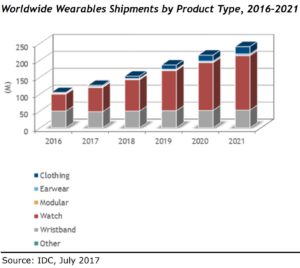Big Data and healthcare
Data is being generated at a rapidly growing pace. IBM claims that 90% of the data in the world has been generated in the last two years, or in other words, 2.5 quintillion bytes of data are created every day [1]. This data holds a lot of value for many different industries, as it contains information that can be used to uncover patterns and create predictive models that explain a given phenomenon. One such case is the healthcare industry, where the increase of medical data generation could lead to more accurate disease diagnoses.
First of all, where does the increase of health data generation come from? Mainly from wearables. These devices can continuously keep track of health indicators such as heart rate, sleep, and activity. Most of the current wearable devices that record health data revolve around fitness and are at a recreational level, but this technology has the potential of monitoring and preventing diseases at a clinical level [2]. An example of clinical-level wearable is Dexcom, a continuous glucose monitoring system [3]. This device is FDA approved, it monitors the glucose levels of users every 5 minutes and notifies the user if his or her glucose level is below, above, or inside an ideal range. The data is summarized in a chart and both the patient and the doctor can visualize it, and the latter can make adjustments to the treatment if necessary.
The data gathered by wearables will continue to increase as more and more people use them. According to IDC’s latest forecast, by the end of this year, worldwide wearables shipments will reach 125.5 million units. And in 2021, total volumes will reach 240.1 million units shipped worldwide [4]. As wearable shipments increase, a shift in the product type is also expected. Currently, most health trackers come in the form of a wristband or integrated in a smartwatch, but in the next few years, they could be implemented in smart clothing, a wearable product type that is foreseen to grow rapidly, as shown in the graph below.

Smart clothing can further improve the monitoring of health, as smart shirts, pants, shoes, and even socks can be used by athletes for measuring their vital signs and muscle activity to prevent injury [5]. Or, in a more clinical application, a smart hat can monitor the pulse rate, respiratory rate, blood oxygen saturation, and temperature of critically ill newborns [6].
Regarding disease diagnosis, big data paired with AI can lead to more accurate patient analysis. For example, IBM’s AI system, Watson, is being used in the University Hospital of Marburg’s Centre for Undiagnosed and Rare Diseases. Here, Watson was able to diagnose correctly a couple of dozen sample cases taken at random from 500 past patient records [7]. The benefits of using an AI to make diagnosis are evident. As these systems can analyze millions of scientific papers and patient records faster than any human, they are capable of returning accurate diagnoses faster, and as data increases, these results will only get better and faster.
In addition to disease diagnosis, AI systems can also be used to determine the best treatment plans. In a test conducted by the University of North Carolina School of Medicine, Watson was given 1,000 cancer diagnoses. In 99% of the cases, Watson suggested the same treatment plans that were suggested by oncologists, and in 30% of the cases it suggested treatments that human doctors did not even take into account [8]. This can certainly lead to a more effective disease treatment.
In conclusion, big data is a valuable tool for the healthcare industry. With it, it is easier to monitor a person’s well-being and determine when said person’s health may be compromised. And with the help of AI, all the data gathered can be analyzed and used to determine which kind of disease someone may have, and suggest the best course of action to return to a healthy state. On the long term, all of this could minimize the risk of disease and lead to higher life expectancy.
References
[1] https://www-01.ibm.com/common/ssi/cgi-bin/ssialias?htmlfid=WRL12345USEN
[3] https://www.dexcom.com/continuous-glucose-monitoring
[4]http://www.idc.com/getdoc.jsp?containerId=US41979617&pageType=PRINTFRIENDLY#US41979617-S-0002
[5] https://www.wareable.com/smart-clothing/best-smart-clothing
[6] http://www.neopenda.com/products.html
[8] https://futurism.com/ibms-watson-ai-recommends-same-treatment-as-doctors-in-99-of-cancer-cases/
Users who have LIKED this post:
One comment on “Big Data and healthcare”
Comments are closed.


Can’t agree more with you! There is no question about the impact of big data on healthcare industry. As you mentioned, besides monitoring one’s condition change, big data can predict a possible disease he or she may get in the future as well. I guess this is why many early-adopters have been passionate about tracking their personal health/work-out data using the smart devices like Fitbit for the last few years.